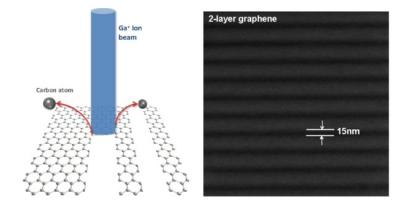Researchers from the University of Utah developed a new way to develop large arrays of graphene nanoribbons (GNRs), aiming for applications in photodetectors. Their method can directly write a large array of 15nm GNRs on a multilayer epitaxial graphene sheet using Focused Ion Beam (FIB).

The researchers accelerated ga+ ions to 30 keV in vacuum using a FEI Helios NanoLab 650 dual-beam FIB machine. This removed carbon atoms from the graphene sheet with a 1.3 sputtering yield (carbon/Ga+ ratio). This technology can be easily transferred to pattern other graphene nanostructures such as spheres, rings and blocks.
Patterning a graphene sheet into an array of GNRs creates a beneficial band-gap opening and plasmonic effect that aids photodetectors. The researchers fabricated a photodetector using an array of three hundred 20nm GNRs and studied its photo response under different laser powers. Under zero-bias, the photoresponsivity of the device was estimated to be 7.32 mA/W.
The researchers now are working on narrowing the GNRs to sub-10nm and reduce pattern pitch size. This could lead to a direct observable band-gap and stronger plasmonic effect - and so find applications in solar cells, LEDs and transistors.

